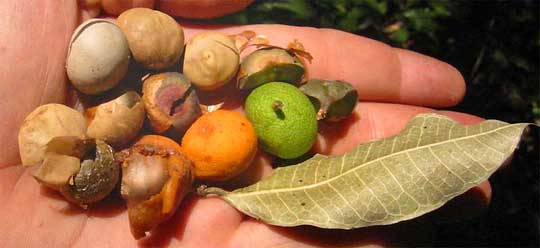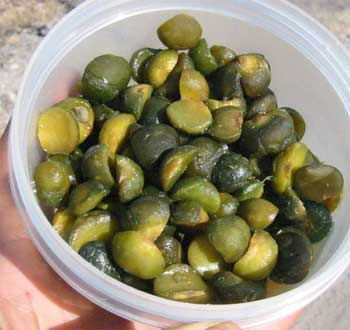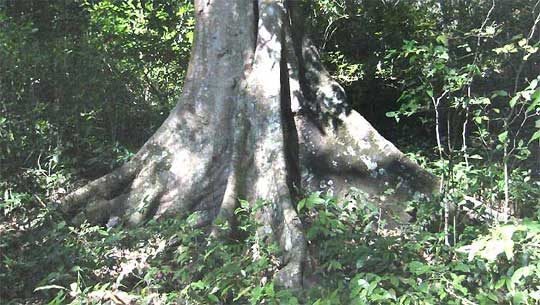Excerpts from Jim Conrad's
Naturalist Newsletter
from the February 11, 2008 Newsletter written in the community of 28 de Junio, in the Central Valley 8 kms west of Pujiltic, elev. ~700m (2300ft), ~N16.331°, ~W92.472°; southeastern Chiapas state, MÉXICO
RAMÓN REVISITED
In certain parts of this community's small reserve Ramón is the most common tree. They're old, stately trees, too, producing enormous quantities of fruits, which in some places cover the ground as if someone had spilled a big bag of brown marbles. You can see several fruits in various states of maturity below:

In that picture a dry Ramón leaf displays its typical herring-bone pattern venation. Ramón is a member of the Fig Family so it's looking like a leaf from an American strangler fig is no accident.
Also you can see that the fruit's hard, nutlike part is covered by a warty skin that's orange when mature. That covering is mildly sweet and not bad to eat, but the main eating is in the nut part.
People here call the tree and its fruit "Talcoít" and have never heard of my name of Ramón. When I asked a fellow if he'd heard of Yerba Buena's name Cacaté he said he had Cacaté on his land, but it wasn't the same as my Ramón. He took me to a small tree heavy with orange fruits, each fruit subtended by a persistent, leathery calyx. He told me to take a bite, and I did. Puckery! I'd expected that, because with those leathery sepals it had to be the local persimmon. I'd hoped it would be ripe, but it hadn't been. Later the fellow said that his "Cacatés" eventually get sweet, too, just like our northern persimmons in late fall.
Anyway, when my friend Antonio saw me carrying the Ramón fruits to photograph he told me he'd fix me a meal by boiling the hard nuts with ashes, the ashes needed to help the hard fruits soften. Later that day he brought me what he'd promised, shown below.

They tasted a little like boiled peanuts and had the same texture. Antonio eats them and other things he finds in the forest, and tells about a famine that came through here years ago, maybe in the 20s he says, when all the crops failed but people kept alive eating this fruit. I think I've read that the ancient Maya depended on them the same way, often storing them for long periods. The tree's leaves and young branches are much used as livestock food.
My Plantas Medicinales de México says that the white-latex-producing fruits are used to encourage new mothers to lactate, but around here the trees and their fruits aren't regarded as medicinal. I read that the fruits can be roasted, ground, and the resulting powder used to make a drink rather like coffee.
This is simply one of the most useful and wonderful trees I know and should be planted throughout the world's tropics in anticipation of a collapse of the international trading system. As we've seen it goes by a host of local names. The name to remember is its Latin one, BROSIMUM ALICASTRUM.
from the February 11, 2008 Newsletter written in the community of 28 de Junio, in the Central Valley 8 kms west of Pujiltic, Chiapas, MÉXICO
BUTTRESSED TREE TRUNKS
While gathering Ramón fruits I photographed the base of a Ramón tree trunk in order to show something of which you see a lot around here, a buttressed tree-trunk. Buttressed trunks have widely flaring supports rather like the fins on a rocket, as shown below:

Buttresses help big trees remain upright in soggy ground. Having buttresses must be very effective, because they develop among many unrelated tree species. You see them on certain species of strangler figs, on Ceibas, Mahoganies, Cedros (Spanish Cedars) and many other large and noble trees of the hot, humid lowlands.